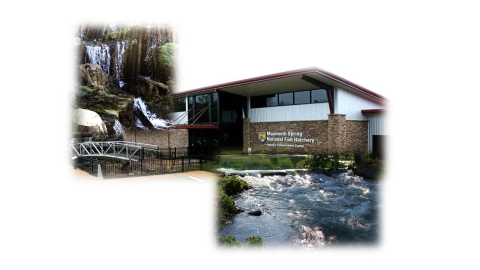
Mammoth Spring is currently open during normal summer hours, 8am - 5pm. We will announce if there are any changes. Please use caution as the railroad is still using the roads around the Hatchery, stay aware and stay safe.
Mammoth Spring National Fish Hatchery's Summer Hours
Summer Hours
Monday-Friday 8am - 5pm
Saturday 9am - 5pm
Sunday Closed
Visit Us
At Mammoth Spring NFH there is an array of activities. First, stop and cross the bridge of the display pond and feed the fish, who know how to beg. Explore our Aquatic Education Center/Aquarium and see several native fish in a new light. Walk through our pollinator garden and witness the incredible service that these animals provide. Take a stroll around our grounds, with unique pond and raceway rearing systems where we raise our aquatic species. The location of this hatchery is also located next to a beautiful state park, historic downtown and one of the world's largest spring. With all of this in one location you could easily make a day full of wonderful memories.
Mammoth Spring NFH is just one of the many field stations of the U.S. Fish and Wildlife Service whose mission is working with others to conserve, protect, and enhance fish, wildlife, and plants and their habitats for the continuing benefit of everyone.
Activities
Environmental education -This hatchery offers educational opportunities and information for visitors during normal operating hours year-round and through our outreach program by appointment.
Walking/Hiking -During normal operating hours there are many walking opportunities on our grounds. There are several ponds to view that have fish and other wildlife.
Archery -There are scheduled events that offer a chance to take aim with a bow and arrow and learn a new skill.
Birding -There are many species of birds on site and numerous opportunities for birding.
Photography -There are numerous living things like frogs, plants, birds, foxes, blue heron, bald eagles and more that can be the next star of your photography exertions.
Annual kids Fishing Day- Date to be determined each year- Watch the hatchery's Facebook page.
Trails
While there are no official trails to walk, the station has numerous other areas that can be walked to view wildlife and aquaculture activities.
Other Facilities in the Complex
LEED Leadership, Energy, Environmental, Design
LEED was developed by U.S. Green Building Council (USGBC). LEED provides building owners and operators framework for construction, operation, and maintenance solutions for a green building design. LEED strives for improvements for the environmental and human health. They concentrate on five key categories. The five key categories are sustainable sites, water efficiency, energy and atmosphere, materials and resources, and indoor environmental quality.
Recycled Material Used in The Aquatic Conservation Center
- Steel frames, studs, roof, and wall panels made from 100% recycled steel.
- Carpet made from 45% recycled fiber (used plastic).
- Metal doors made from 59% recycled metal.
- Window frames made from 70% recycled material.
- Glazing (window glass) made from 100% recycled glass.
- Interior wood trim 100% reclaimed from old barn.
- Wood for interior benches 100% from old barn.
- Exterior concrete benches 100% from old barn.
- Ceiling tiles are made of 85% recycled material.
- Ceiling Grid is made from 100%recycled material.
Hatchery Water Cycle
Naturally Cooled spring water from Mammoth Spring is used for hatchery production and to conserve energy in the Aquatic Conservation Visitor Center.
- Rain Falls in the Ozark Mountains.
- Rain is filtered and cooled to 58 degrees as it percolates deep into the earth, where it becomes supersaturated with nitrogen and other gasses.
- Many subterranean streams eventually converge and well up in the spring, some of which is diverted to the hatchery.
- Spring water flows through a series of degassers to reduce the high levels of nitrogen that may be harmful to fish before being used for production. Some of this water is sent to the Visitor Center.
- At the Visitor Center, the water passes through a heat exchanger that uses the 58-degree water to heat and cool the Visitor Center.
- After the water is used in the heat exchange it is reused for other purposes.
a) Water is returned to the Spring River
b) Small amounts of water are used to irrigate plants around the Visitor Center.
c) Spring water is diverted to production ponds and used to raise fish
8. Water is evaporated from ponds and the river to clouds and rain starts the process again.
Find out more information at the LEED website:
Rules and Policies
We ask that you be respectful to the animals that are on display here at the hatchery. Many of these animals have given up their natural life to serve as educational animals. Please, also, respect the facility and staff, many of them are our amazing volunteers that give their time to help us achieve our goals. Our grounds are open to the public to walk and view, however, please be respectful of others, and pick up after yourself and no driving on the hatchery grounds.
Locations



















Mammoth Spring National Fish hatchery is located just behind Mammoth Spring State Park nestled between the railroad tracks and the Warm Fork River.
- From HWY 63, Turn East onto North Park Drive (Just North of the spring);
- The road changes to State Line Drive;
- At the fork turn right onto state Park Drive;
- Cross the Railroad Tracks;
- The Hatchery will be straight ahead.



